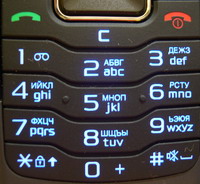Klava for sotik

Suppose you have an ancient phone model without T9.
The disadvantage of the cell phone keypad is that the letters of the Russian and English languages are arranged in alphabetical order. If you arrange the letters according to the frequency of their use, the typing speed will increase, along with this, the time spent and the energy of the phone decreases (as was done, for example, on a computer keyboard)
There are no analogs of such keyboards on cell phones. (?)
The novelty and attractiveness of new cell phone models will immediately attract the bulk of users (teenagers) who more and more often communicate by typing short text messages: sms.
A computer keyboard is an alphabet ordered by the frequency of use of each letter. (Not alphabetically)
Under each finger is the letter that is most often printed.
Cell phone keyboards are made differently:
The letters are arranged in alphabetical order and due to this the typing speed drops significantly. You have to spend a lot of time “clicking through” a certain letter.
The frequency of use of letters of the Russian alphabet is presented in the table:
')
| letter | probability | letter | probability | letter | probability | letter | probability |
| space | 0.145 | R | 0.041 | I | 0,019 | x | 0,009 |
| about | 0.095 | at | 0.039 | s | 0.016 | well | 0,008 |
| her | 0.074 | l | 0.036 | s | 0.015 | Yu | 0,007 |
| but | 0.064 | to | 0.029 | , | 0.015 | sh | 0,006 |
| and | 0.064 | m | 0.026 | b | 0.015 | c | 0,004 |
| t | 0.056 | d | 0.026 | g | 0.014 | u | 0,003 |
| n | 0.056 | P | 0.024 | h | 0.013 | uh | 0,003 |
| with | 0.047 | at | 0.021 | th | 0.01 | f | 0,002 |
(The label is taken from the Internet. Yes, and in the analysis of any huge text, you can make the same table)
The same can be done for the English Claudia.
By placing the letters on each key, we get something like the following:
1 = o, l, b, w
2 = e, k, b, c
3 = a, m, b, u
4 = i, d, g, uh
5 = t, n, h, f
6 = n, y, d
7 = s, i, x
8 = p, s, w
9 = B, W, W,
0 = space
Consider an example of using a standard cell phone keyboard and this one:
Word:
Hello
on a simple keyboard will present:
letter n 4 presses
letter p 1 press
letter and 1 press
letter in 3 clicks
letter e 2 presses
letter t 3 press
total: 14 clicks
Oh yeah. Check it out! Turn off the T9. Type the word;)
on this keyboard:
letter n 2 press
letter p 1 press
letter and 1 press
letter in 1 click
letter e 1 click
letter m 1 press
total: 7 clicks
Text:
" Contest winners are eligible "
on a simple keyboard is: 66 clicks
On this: 43 clicks which is 23 clicks less than a simple keyboard!
And if this still attach T9? %)
Well, yes, at first it will be a little awkward ... to wean and get used to it in a new way. But maybe worth it.
Why am I writing this? Well, just share an idea. You can say go patent. Yes, what kind of patent can there be if sensory sensations are now popular? Everything is different there already ...
Although, for the numlok you can somehow use;) make a program to make it easier for people with disabilities to type. I do not know
Source: https://habr.com/ru/post/53885/
All Articles